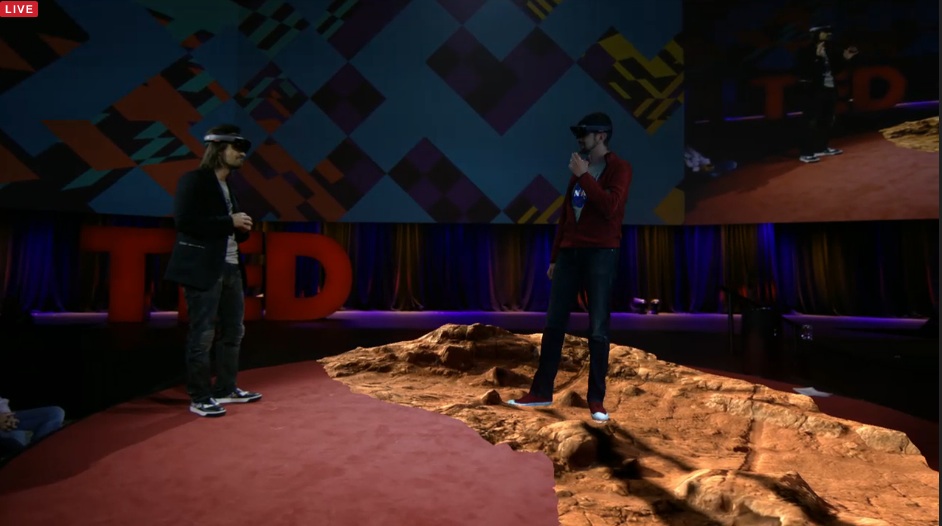HoloLens 'Teleports' NASA Scientist to Mars in TED Talk Demo

Something amazing happened at the TED2016 conference today: HoloLens developer Alex Kipman "teleported" a NASA scientist onto the stage, on the surface of Mars.
Jeff Norris of NASA's Jet Propulsion Laboratory was physically across the street from the auditorium in Vancouver, Canada, but with the HoloLens cameras, a hologram of him (a three-dimensional, talking hologram, which is made entirely of light) was beamed onto the stage where a virtual Mars surface was waiting.
"I'm actually in three places," Norris said. "I'm standing in a room across the street, while I'm standing on the stage with you, while I'm standing on Mars a hundred million miles away." [See Photos of the HoloLens Experience and Teleported Scientist]
Kipman demoed the HoloLens for the audience and, for the first time, revealed this new holographic teleportation aspect of the technology.
"I invite you to experience, for the first time anywhere in the world, here on the TED stage a real-life holographic teleportation…," Kipman said. When Norris, wearing a NASA T-shirt and baseball cap appeared onstage (his hologram, that is), Kipman was ecstatic. "Woo. That worked," he said.
The alien scape on which Norris stood was a holographic replica of the planet created from data collected by NASA's Curiosity rover.
To infinity and beyond
Get the world’s most fascinating discoveries delivered straight to your inbox.
Kipman sees the technology as a game-changer for the world. Today, he says, humans are limited by our two-dimensional interaction with the world, through monitors and other screens.
"Put simply I want to create a new reality," Kipman said. "A reality where technology brings us infinitely closer to each other, a reality where people, not devices, are at the center of everything. I dream of a reality where technology senses what we see, touch and feel, a reality where technology no longer gets in the way but instead embraces who we are."
Enter the HoloLens: "This is the next step in the evolution. This is Microsoft Hololens, the first fully untethered holographic computer," said Kipman. "I'm talking about freeing ourselves from the 2D confines of traditional computing." [Here's How the Microsoft HoloLens Works]
The technology relies on a fish-eye camera lens, loads of sensors and a holographic processing unit, according to Microsoft.
And to allow the viewer to walk around in their own environment overlaid with various holograms, the devices maps your home or any surroundings in real-time. "The HoloLens maps in real-time at about five frames per second with this technology we call spatial mapping. So in your home as soon as you put it on holograms will start showing up and you'll start placing them, you'll start learning your home," Kipman said.
For the demo, where Kipman's headset was wirelessly linked to big screens, the HoloLens relied on stored information. "In a stage environment where we're trying to get something on my head to communicate with something over there with all of the wireless connectivity that usually brings all conferences down we don't take the risk of trying to do this live," Kipman said. "So what we do is we pre-map the stage at five frames per second with the same spatial mapping technology that you'll use with the product at home and then we store it."
Demoing more of the HoloLens experience, Kipman shows the audience what he sees through the headset as he dials his world from reality toward the imaginary, turning people in the audience, for instance, into elves with wings.
Exploring with HoloLens
The technology is already being put to good use in the scientific and consumer realm.
Medical students at Case Western University are using HoloLens to learn about medicine and the human body in an augmented-reality world; Volvo has developed a partnership with Microsoft to use the HoloLens for both design of their cars and as a way to enhance consumers' experiences with their vehicles and brand.
And Kipman's "personal favorite" — NASA is using the technology to let scientists explore planets holographically, a partnership dubbed OnSight.
"Today a group of scientists on our mission are seeing Mars as never before, an alien world made a little more familiar because they are finally exploring it as humans should," Norris said of the ability to use HoloLens to experience the planet as if one were there. "But our dreams don't have to end with making it just like being there. If we dial this real world to the virtual, we can do magical things. We can see in invisible wavelengths or teleport to the top of a mountain. Perhaps some day we'll feel the minerals in a rock just by touching it."
Astronauts aboard the International Space Station have HoloLens headsets so that scientists on Earth can assist them as if both were in the same place.
Follow us @livescience, Facebook& Google+. Original article on Live Science.
Jeanna Bryner is managing editor of Scientific American. Previously she was editor in chief of Live Science and, prior to that, an editor at Scholastic's Science World magazine. Bryner has an English degree from Salisbury University, a master's degree in biogeochemistry and environmental sciences from the University of Maryland and a graduate science journalism degree from New York University. She has worked as a biologist in Florida, where she monitored wetlands and did field surveys for endangered species, including the gorgeous Florida Scrub Jay. She also received an ocean sciences journalism fellowship from the Woods Hole Oceanographic Institution. She is a firm believer that science is for everyone and that just about everything can be viewed through the lens of science.


